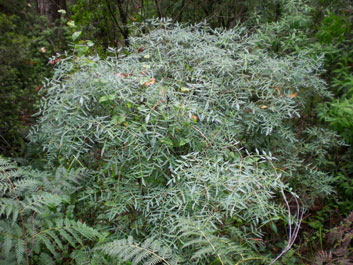 |
Botanical tours in search of... the Native Elderberry
There I was camped by a billabong (Chapple Creek) in the remote southwest corner of the Otways reading the latest edition of Costerman's "Trees and Shrubs of Southeastern Australia" when I happened upon page 254. My eyes lit up when I discovered the rare Elderberry Panax (Polyscias sambucifolia) does grow in this part of the Otways. In fact the Otway plants make up the western most population in Australia with the nearest population in the Dandenongs.
I had been tramping over this neck of the woods for a few days looking for seed, taking snaps of plants and basically just relaxing so I was rarin' to go for a good plant investigation. The Elderberry panax belongs to the Araliaceae family of which the most well known genus is Hedera (ivy). Araliaceae is closely related to the Apiaceae family. They both have their flowers in an umbel (resembles an umbrella). However the Araliaceae form succulent fleshy seeds (fruit) and Apiaceae form dry seeds. Plants in the Apiaceae family include dill, parsley and our own basalt plains favourite, the blue devil.
The Elderberry Panax is not related to the Northern Hemisphere plant, elderberry, however, early Europeans saw a resemblance in the flowers and in some bushes the production of white- mauve berries. I haven't been able to find any references to indigenous Australian names for the plant and only anecdotal references to Aboriginal uses of the plant. Most books state the berries are edible (in fact succulent, tasty, etc) but I have drawn a blank as to recipes and bush tucker uses. One local bush food expert reckons they taste more like blueberries than elderberries. I can't wait to try 'em !
There are actually two plants in the Otways that go by the elderberry name. The above elderberry panax and one of the worst named plants ever to be given a botanical name: Sambucus gaudichaudiana (or white elderberry). I'll give you a second or three while you try to pronounce it... Now, as I was saying, both plants have edible berries. The white elderberry is a small shrub to waist high with delicately branched white flowers in early summer. It belongs to the caprifoliaceae family (lonicera or honeysuckle as well). It is almost exclusively a northern hemisphere family with Sambucus its only antipodean member. I have eaten the berries of the white elderberry. They are a translucent white colour about the size of a currant. The juicy fruit is somewhat astringent (like a currant) but sweetens as it ripens. The plant bears large amounts of fruit which, when ripe, fall to the ground very quickly where birds and mammals eat them with gusto. They grow in shady, moist forests usually near streams. These plants readily germinate from seed. Collect the fresh seed and squeeze the juice out into a glass. (chill and drink later, yum). The seeds left over can then be rubbed through a sieve to remove skins and extra pulp. Sow the seeds in seed raising mix- not too deep or too thick. They usually germinate in about a month. The seed can be dried and stored as well (in a cool dark place) and sown at a later stage.
The elderberry panax (that's the plant I'm actually supposed to be writing about) has a novel pinnate leaf form which isn't well represented in the Otways. There are actually three leaf shapes within the species across Australia thus the plant found in the Otways has a narrow serrated pinnate leaf (see photo) while in other regions the leaf can be quite a broad pinnate leaf or even bipinnate leaf (like a black wattle). The elderberry panax suckers and root cuttings are an easy way of propagating the plant. The shrub grows to about 4 m tall and tends to grow into a dense screen with a somewhat weeping habit. In the Otways it grows in about 600-800mm rainfall on moist soils. It grows in association with brown stringybark, messmate, silver banksias, balm mint bush, hop goodenia, tree everlasting, sallow wattle, and prickly tea tree.
Well, now back to the camping trip. I decided to look for the plant in bush areas adjacent to the Gellibrand River where the map in Costerman's book hinted at being where the species might be found. I drove up hill to Lavers Hill, over to Moonlight Head and Lower Gellibrand, and up to Carlisle River. Saw some magnificent country. Obviously took in the rainforest at Lavers, and coastal forest near Lower Gelli, but the starkness and botanical variety on the Grasstree Plain near Chapple Vale was most interesting. Treeferned gullies dissected banksias, hakeas, grass trees, purple flag irises, egg and bacons, and prickly geebungs with the odd twisted brown stringybark. One track led to another and I eventually found myself in the Devondale area with rich river flats on one side and prickly tea tree on the other. A great spot. Even found a nice patch of Mountain Pepper. (Maybe the next article?!)
As the day wore on and the sun began to fade, my campfire next to the billabong (sounds romantic anyway) was beckoning so off I drove and ... wait a minute, what was that on the side of the road. A bush with pinnate leaves and lots of suckers all around growing right on the edge of the road (I'd driven twice before down this track without spotting them) tucked in front of a pine plantation. Yep it was the elderberry panax. I was expecting it to be growing in a protected gully hidden behind a hill miles from anywhere. I was very excited. (Just tremble the paper a little while you read this to help add to the moment!). I took about two thousand photos and my excitement must have been catching because a carload of Japanese tourists stopped to see what I was taking photos of (koalas, frill neck lizards?)
Anyway, I had fun, I had a rest and I found a rare Otway plant that helps make our neck of the woods such an interesting and great place to live in and visit. Feel free to contact me for more information about this plant and others.
Back to Dr. Tree | Previous article | Next article |











